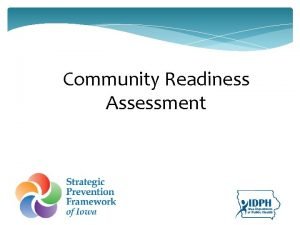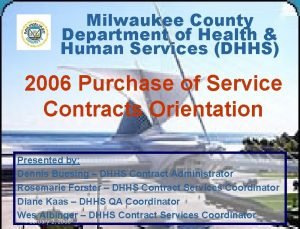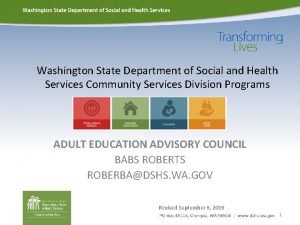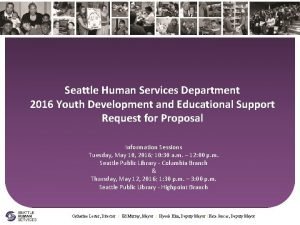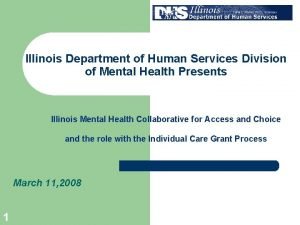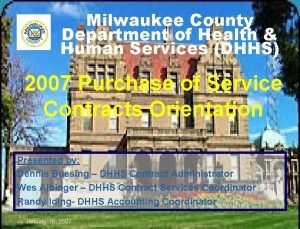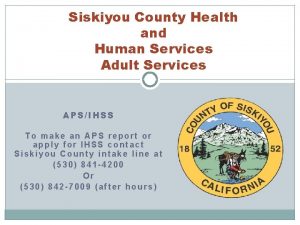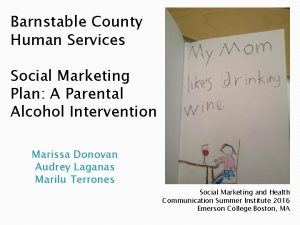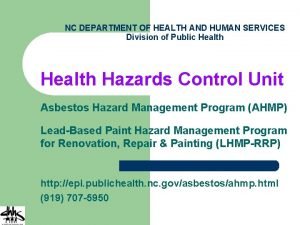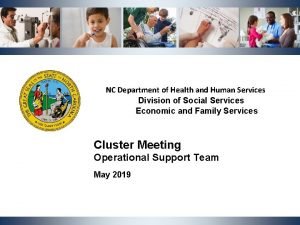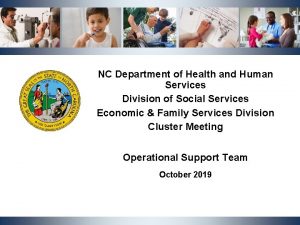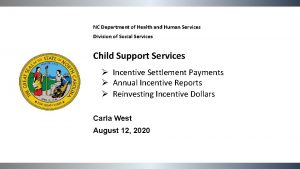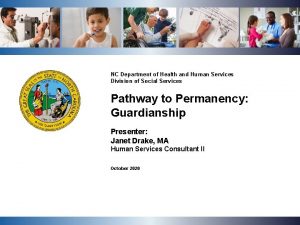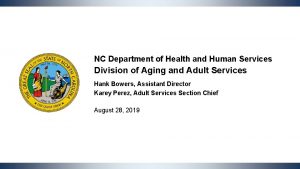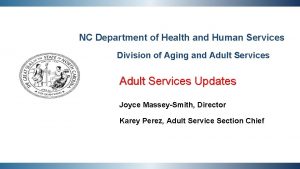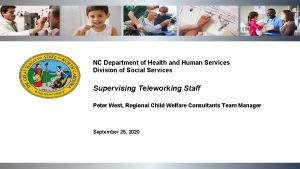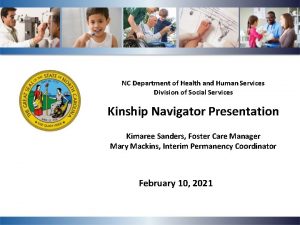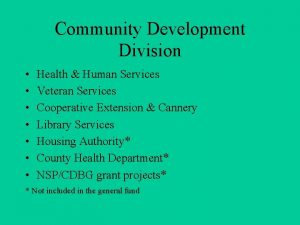Department of Health and Human Services Division of















![Behavioral Health NC’s 1115 Waiver Application indicates “[t]he clinical integration of behavioral health (encompassing Behavioral Health NC’s 1115 Waiver Application indicates “[t]he clinical integration of behavioral health (encompassing](https://slidetodoc.com/presentation_image_h2/732843c7c1e77a063d0a85d4ff9be1a4/image-16.jpg)


- Slides: 18

Department of Health and Human Services Division of Health Benefits NC Dual Eligibles Advisory Committee September 23, 2016

Welcome NC Department of Health and Human Services Dee Jones Dave Richard 2

Agenda • Member Introductions • Dual Eligibles Report Timeline • Status of Data Requests • Prior Advisory Committee Results • Group Discussion • Next Steps 3

Member Introductions 4

Propose Report Structure 24 days Aug-23 Sep-23 Review Provided Information 24 days Aug-23 Oct-23 Committee DEAC Written Recommendations 40 days Oct-23 Nov-17 Committee Work on Report 65 days Sep-26 Dec-23 DHHS Jan-03 DHHS 4 days Jan-03 Jan-06 All Parties 3 days Jan-06 Jan-10 DHHS Send to DHHS Executive Team Jan-11 DHHS Executive Team Review Jan-11 Jan-16 DHHS Jan-16 Jan-23 DHHS Jan-31 DHHS Send Near Final Report to Team 1 Team Review / Feedback Revisions based on Team Feedback Final Edits 6 days Submit Report 1 Team Jan-30 Jan-23 Jan-16 Jan-09 Jan-02 Dec-26 Dec-19 Dec-12 Dec-05 Nov-28 Nov-21 Denotes Advisory Committee Meetings Nov-14 Nov-07 Oct-31 Oct-24 Oct-17 Oct-10 Oct-03 Sep-26 Sep-19 Sep-12 FINISH RESOURCE Aug-23 DHHS Sep-05 START Aug-23 Aug-29 DURATION Aug-22 TASK Present Report Timeline Aug-15 Dual Eligibles Report Timeline DHHS Review consists of the Advisory & Steering Committees along with the DHHS Planning Team 5

Status of Data Requests 6

Completed Requests • More up-to-date enrollment • Eligibility group descriptions • Population by region and rural/urban status • Population by living arrangement • Explanation for Medicaid-only disabled enrollment • List of mandatory vs. optional services • Population served by medical homes • MLTSS Utilization Changes (sent 9/2) 7

Status of Outstanding Requests Request Status Diagnosis/Co-morbidity data Requested internally; may only include FFS data Additional detail on HMO premiums Requested internally Split out utilization and claims by partial vs. full duals Requested internally Distribution of claims to identify high utilizers Requested internally Income levels of people who qualify for spend down Requested internally Volume of services utilized Requested internally Number of duals utilizing services through LME-MCOs Requested from consultant Incorporation of Medicare data is not available; not feasible to obtain in the time period for the Dual Eligibles Advisory Committee 8

Prior Advisory Committee Results During the last meeting, the Duals Advisory Committee responded to four questions related to how and when the duals population should be incorporated into managed care. The Steering Committee then reviewed these responses and worked to consolidate them into very specific recommendations. 9

Summary Outcomes from Prior Discussions • Duals should be implemented after managed care has been proven with the Medicaid-only population. • Integration of duals into managed care should be conducted in carefully planned phases based on services and other key considerations. • Partial duals should not be included in the initial implementation of duals into managed care. 10

Digging Deeper… Now that we know who should be integrated into managed care, and when this should occur, let’s talk more about how they should be integrated. • Waiver Goals • Care coordination • Behavioral health • Readiness 11

Group Discussion Include the group’s perspective of recommendations shared in these materials. q Whole Person Care Workgroup q Consumer Experience in Medicaid Managed Long-Term Services and Supports Programs 12

Ensuring Quality, Integrated Services: The Dually Eligible Beneficiary Experience 13

LTSS Goals Identified in NC’s 1115 Waiver Application includes a number of LTSS-related goals that health plan design should address [Section 2. 3. 1. 4]. – Support and build a system that promotes consumer choice – Build upon current system by ensuring continued access to facility-based services when necessary, and expanding continuum of services and variety of settings in which to receive them – Promote use of enabling technology – Invest in service strategies that prevent, delay or avert need for Medicaid-funded LTSS through appropriate upstream interventions – Recognize and bolster key role family caregivers and other natural supports play in supporting beneficiaries with long-term care needs to delay or divert use of institutional services – Ensure that LTSS beneficiaries have access to, as needed, hands-on streamlined service coordination that is responsive to their clinical and social needs – Focus on care transitions and opportunities for early interventions related to transition planning • What, if any, are the “Duals-specific” considerations as NC works to address each of these goals in health plan structure? • What additional goals that are not reflected in this list need to be considered for the LTSS needs of Duals and NC’s aging population to be effectively addressed in the health plan design? 14

Care/Service Coordination Research and experience, including recommendations which emerged from the DHHS Whole Person Work Group, recognize the essential role of care coordination in a quality, integrated managed program. • Are there any additional considerations about care coordination that need to be added to the Whole Person Care workgroup recommendations? • What are the special considerations for care coordination design as it relates to the Duals specifically? – Management of chronic illness? – Specific capacities/sensitivities around supporting older adults and people with physical disabilities? – Specific capacities in coordinating Medicare-funded benefits/services? • Are there specific capacities that need to be developed to better facilitate outcomes related to social determinants of health? – Adequate housing – Viable employment opportunities – Effective transportation. • What additional questions or “unknowns” did this conversation generate? 15
![Behavioral Health NCs 1115 Waiver Application indicates the clinical integration of behavioral health encompassing Behavioral Health NC’s 1115 Waiver Application indicates “[t]he clinical integration of behavioral health (encompassing](https://slidetodoc.com/presentation_image_h2/732843c7c1e77a063d0a85d4ff9be1a4/image-16.jpg)
Behavioral Health NC’s 1115 Waiver Application indicates “[t]he clinical integration of behavioral health (encompassing mental health and substance use disorders) and primary care is a priority for North Carolina. ” [See section 2. 3. 1. 3, NC 1115 Waiver Application, June, 2016]. Many Duals are dually eligible because of behavioral health-related disabilities and are currently served by NC DHHS’ LME-MCOs. • Based on your experience, what are the considerations for ensuring individuals who are accessing services through both a PHP and an LME-MCO have the most integrated, coordinated experience possible? • What additional questions or “unknowns” did this conversation generate? 16

Evidence of Readiness The importance of “readiness” prior to a state transitioning into a Medicaid managed delivery model is well documented. • Readiness requires meaningful input and feedback from beneficiaries. Yet, many standard methods for engaging stakeholders in dialogue may be ineffective for engaging dually eligible beneficiaries, who may disproportionately experience challenges related to transportation and internet access. What are some methods NC can use to ensure beneficiary education, input and feedback throughout the Reform process? • Duals’ enrollment into a Medicare managed care program is voluntary. This becomes a consideration if NC pursues a Medicaid/Medicare integrated service delivery model. What are the essential topics that individuals counseling beneficiaries on enrollment options (enrollment brokers) will need to discuss to assist the dually eligible beneficiary in making an informed decision about whether to enroll? • What are the key milestones that need to be met for determining readiness for the transition to managed care for dually eligible beneficiaries? In other words, how will the State know the best time to go live with managed care? 17

Next Steps • Advisory Committee: Develop the full written recommendations that will be incorporated into the Legislative Report • DHHS: Develop the Legislative Report 18
 Iowa department of health and human services
Iowa department of health and human services Milwaukee county human services
Milwaukee county human services Maine department of health and human services
Maine department of health and human services Washington state department of social and health services
Washington state department of social and health services Department of health and senior services missouri
Department of health and senior services missouri Seattle human services department
Seattle human services department Icg grant illinois
Icg grant illinois Delaware county department of human services
Delaware county department of human services Merck human health division
Merck human health division Louisiana health standards
Louisiana health standards Milwaukee county human services
Milwaukee county human services Siskiyou county ihss
Siskiyou county ihss Barnstable county human services
Barnstable county human services Wake county human services community services center
Wake county human services community services center 369 times 2
369 times 2 Repeated subtraction for division
Repeated subtraction for division What is the missing number in the synthetic-division array
What is the missing number in the synthetic-division array Sunthetic division
Sunthetic division Department vs division
Department vs division
